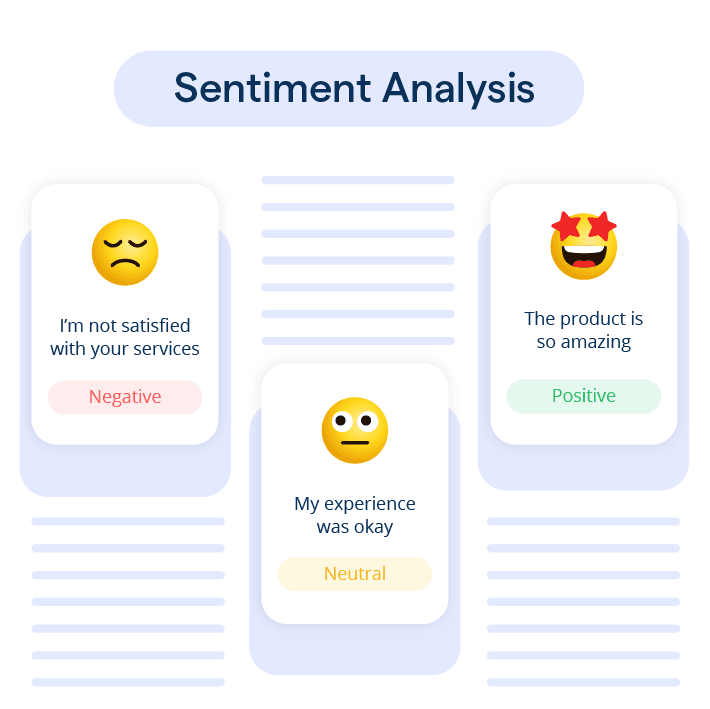What is Sentiment Analysis?
Sentiment Analysis is the process of using natural language processing, text analysis, and computational linguistics to identify and extract subjective information from text. This information can be used to determine the sentiment of a piece of text, whether it is positive, negative, or neutral. Sentiment Analysis has become increasingly important in recent years as more and more businesses turn to social media and other online platforms to engage with customers and monitor their brand reputation.

Types of Sentiment Analysis
There are several types of Sentiment Analysis, including:
- Document-level Sentiment Analysis: This type of analysis determines the overall sentiment of a document, such as a customer review or social media post.
- Sentence-level Sentiment Analysis: This type of analysis determines the sentiment of each individual sentence in a document.
- Aspect-based Sentiment Analysis: This type of analysis determines the sentiment of specific aspects or features of a product or service mentioned in a document.
Techniques for Sentiment Analysis
There are several techniques used in Sentiment Analysis, including:
- Rule-based techniques: These techniques use a set of predefined rules to determine the sentiment of a piece of text.
- Machine learning techniques: These techniques use algorithms to learn from data and identify patterns that can be used to determine the sentiment of a piece of text.
- Hybrid techniques: These techniques combine rule-based and machine learning techniques to improve the accuracy of Sentiment Analysis.
Approaches to Sentiment Analysis
There are two main approaches to Sentiment Analysis:
- Supervised learning: This approach involves training a machine learning model on a labeled dataset of text and sentiment.
- Unsupervised learning: This approach involves clustering similar pieces of text together based on their sentiment.
Why is Sentiment Analysis important?

Business Applications of Sentiment Analysis
Sentiment Analysis has several important business applications, including:
- Brand reputation management: By monitoring social media and other online platforms, businesses can quickly identify and respond to negative sentiment about their brand.
- Customer service improvement: By analyzing customer feedback, businesses can identify areas for improvement and make changes to improve the customer experience.
- Product development: By analyzing customer feedback, businesses can identify what customers like and dislike about their products and use this information to improve future products.
Social media monitoring
Social media has become a key platform for businesses to engage with customers and promote their brand. Sentiment Analysis can be used to monitor social media and identify trends in customer sentiment.
Brand reputation management
Negative sentiment about a brand can spread quickly on social media and other online platforms. Sentiment Analysis can be used to quickly identify negative sentiment and respond to it before it becomes a larger issue.
Customer service improvement
Customer feedback can be a valuable source of information for businesses. Sentiment Analysis can be used to analyze customer feedback and identify areas for improvement in customer service.
Who uses Sentiment Analysis?
Industries that use Sentiment Analysis
Sentiment Analysis is used in a variety of industries, including:
- Marketing and advertising
- Customer service
- Product development
- Politics and public opinion
Roles that use Sentiment Analysis
Sentiment Analysis is used by several different roles within a business, including:
- Marketing and advertising professionals
- Customer service representatives
- Product managers
- Data analysts
Examples of companies that use Sentiment Analysis
Several large companies use Sentiment Analysis, including:
- Amazon: Amazon uses Sentiment Analysis to analyze customer reviews and improve product recommendations.
- Twitter: Twitter uses Sentiment Analysis to identify trending topics and monitor user sentiment.
- Airbnb: Airbnb uses Sentiment Analysis to analyze customer reviews and improve the customer experience.
Where is Sentiment Analysis used?

Platforms that use Sentiment Analysis
Sentiment Analysis is used on several different platforms, including:
- Social media platforms: Sentiment Analysis is commonly used on social media platforms like Twitter and Facebook to monitor user sentiment.
- Customer feedback channels: Sentiment Analysis is used to analyze customer feedback from sources like surveys and customer support tickets.
- Product review websites: Sentiment Analysis is used to analyze customer reviews on websites like Amazon and Yelp.
Social media platforms
Social media has become a key platform for businesses to engage with customers and promote their brand. Sentiment Analysis is commonly used on social media platforms like Twitter and Facebook to monitor user sentiment.
Customer feedback channels
Customer feedback can be a valuable source of information for businesses. Sentiment Analysis is used to analyze customer feedback from sources like surveys and customer support tickets.
Product review websites
Product review websites like Amazon and Yelp are a valuable source of information for customers. Sentiment Analysis is used to analyze customer reviews and provide insights into what customers like and dislike about a product.
How does Sentiment Analysis work?
Steps involved in Sentiment Analysis
Sentiment Analysis typically involves the following steps:
- Text preprocessing: This involves removing stop words, punctuation, and other noise from the text.
- Feature extraction: This involves identifying the most important features of the text, such as keywords and phrases.
- Sentiment classification: This involves using a machine learning algorithm to classify the sentiment of the text.
- Evaluation: This involves evaluating the accuracy of the Sentiment Analysis model.
Tools and technologies used for Sentiment Analysis
There are several tools and technologies used for Sentiment Analysis, including:
- Natural Language Processing (NLP) libraries like NLTK and spaCy
- Machine learning libraries like scikit-learn and TensorFlow
- Sentiment Analysis APIs like the Google Cloud Natural Language API and the IBM Watson Tone Analyzer
Challenges in Sentiment Analysis
There are several challenges faced in Sentiment Analysis, including:
- Accuracy issues: Sentiment Analysis models may not always accurately classify the sentiment of a piece of text.
- Language and cultural barriers: Sentiment Analysis models may not work well for languages and cultures that are different from the training data.
- Privacy concerns: Sentiment Analysis models may be used to analyze personal data, which raises privacy concerns.
Sentiment Analysis vs. Text Analysis
Sentiment analysis aims to determine the sentiment or emotion behind a piece of text, while text analysis encompasses various techniques to process and extract insights from unstructured text data.
Focus
Sentiment analysis specifically focuses on understanding feelings and opinions, whereas text analysis covers a broader range of tasks, including sentiment analysis, information extraction, and summarization.
Techniques
Both sentiment analysis and text analysis use natural language processing and machine learning techniques, but text analysis may involve additional methods, such as tokenization, stemming, and named entity recognition.
Complexity
Text analysis can be more complex than sentiment analysis, as it often involves multiple subtasks to derive meaningful insights from unstructured text data.
Use Cases
Sentiment analysis is widely used for social media monitoring and customer feedback analysis, while text analysis has broader applications, including content recommendation, chatbots, and information retrieval.
Sentiment Analysis vs. Opinion Mining
Sentiment analysis focuses on determining the sentiment (positive, negative, or neutral) behind a piece of text, while opinion mining extracts subjective information, such as opinions, beliefs, or evaluations.
Scope
Sentiment analysis generally deals with broader sentiment classification, whereas opinion mining goes deeper into understanding specific opinions and their targets.
Granularity
Opinion mining often involves fine-grained analysis, extracting opinions on specific aspects or features, while sentiment analysis typically provides a more general sentiment overview.
Techniques
Both sentiment analysis and opinion mining use natural language processing and machine learning techniques, but opinion mining may require more advanced approaches to extract detailed opinions.
Applications
Sentiment analysis is commonly used for social media monitoring and customer feedback analysis, while opinion mining can be applied to product review analysis, market research, and competitive analysis.
Limitations of Sentiment Analysis

Handling Sarcasm and Irony
Detecting sarcasm and irony in text can be challenging for sentiment analysis, as the intended meaning may differ from the literal meaning of the words.
Ambiguity and Context Dependence
Sentiment analysis can struggle with ambiguous phrases or words that have different meanings depending on the context, leading to inaccurate results.
Handling Negations
Detecting and interpreting negations, such as "not bad" or "not happy," can be difficult for sentiment analysis algorithms, potentially affecting accuracy.
Identifying Emotion Intensity
Measuring the intensity of emotions or sentiments expressed in text is challenging, as subtle differences in language can significantly impact the meaning.
Adapting to Language Variations
Sentiment analysis algorithms may struggle with variations in language, such as slang, dialects, or informal language, leading to misinterpretations and inaccuracies.
TL;DR
Sentiment Analysis is a valuable tool for businesses looking to monitor their brand reputation, improve the customer experience, and make better decisions. While there are some challenges and limitations to Sentiment Analysis, the benefits are significant. As technology continues to improve, Sentiment Analysis will become even more important for businesses looking to stay ahead of the competition.
Frequently Asked Questions (FAQs)
What is sentiment analysis?
Sentiment analysis is a natural language processing technique used to determine the sentiment or emotion behind a piece of text, such as positive, negative, or neutral.
How does sentiment analysis work?
Sentiment analysis works by using machine learning algorithms or rule-based approaches to analyze text data, identify sentiment-related words or phrases, and classify the overall sentiment.
What is lemmatization and how is it used in sentiment analysis?
Lemmatization is the process of reducing words to their base or root form to normalize variations. In sentiment analysis, it aids in standardizing words for accurate analysis, ensuring that variations like "good" and "better" are recognized as the same sentiment, enhancing the accuracy of sentiment classification algorithms.
Why is sentiment analysis important?
Sentiment analysis helps businesses understand customer opinions, monitor brand reputation, and gain insights for improving products, services, and customer experience.
What are common use cases for sentiment analysis?
Sentiment analysis is commonly used for social media monitoring, customer feedback analysis, product review analysis, and market research.
What are some sentiment analysis tools?
Popular sentiment analysis tools include IBM Watson, Google Cloud Natural Language API, Amazon Comprehend, and open-source libraries like TextBlob and VaderSentiment.

